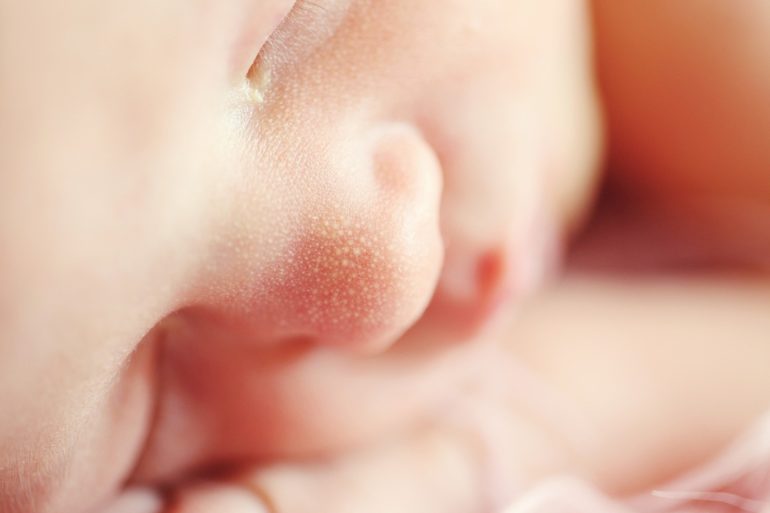The research, carried out using a wearable cuff, provides a new method for monitoring movements in babies, and new insights into how babies’ reflexes—like kicking—develop. These insights and the cuff could also be used to spot early signs of motor disorders such as cerebral palsy.
The research, published today in Science Advances, was done in collaboration with the Santa Lucia Foundation and Casilino Hospital in Rome.
Babies start kicking as foetuses in the womb and continue to kick instinctively until they are around four months old. The kicks mainly involve spinal neurons, as do protective reflexes found in adults like swiftly removing a hand from heat. However, not much is known about how the movement is generated on a neuronal level because detailed analysis of individual nerve cells has previously not been possible without surgery.
Now, Imperial and Santa Lucia Foundation researchers have developed a non-invasive cuff that slips onto freely kicking babies’ legs to monitor neuronal activity without the need for surgery. The system decodes the electrical field potentials on the body surface and mathematically reverses their generation process, thus identifying the neural activity of the spinal cord.
Using the cuff the researchers found that, unlike fast leg movements in adults, babies’ kicks are generated by the neurons in the spinal cord firing at the exact same time. This ‘extreme synchronisation’, the researchers say, increases the force generated by muscles attached to the nerves—which explains why babies’ kicks can be relatively hard and fast even though their muscles are still weak and slow.
The researchers say these results, which are published today in Science Advances, are crucially important for our understanding of the development of spinal neural networks.
Lead author Professor Dario Farina of Imperial’s Department of Bioengineering said: “This is a fundamental discovery of how foetuses and babies develop. The findings, and the new technology that helped us make the discovery, could help monitor development in babies and spot signs of motor disorders like cerebral palsy early on.”
Co-senior author Professor Francesco Lacquaniti of the University of Rome Tor Vergata and Santa Lucia Foundation added: “The new monitoring cuff is an exciting technological achievement that could help us monitor babies for signs of motor problems so that we can diagnose and treat them early.”
Fundamental discovery
The cuff attaches to the lower leg and contains a neuromuscular interface which records the electrical signals on the skin. It then decodes these signals and their timings to work out which spinal cord neurons are firing, and how quickly.
They tested the cuff on four freely kicking healthy babies aged two to 14 days old, and on twelve adult men doing various movements.
They found that in babies, all neurons fire closely in time to generate a kick, whereas there was significantly less synchronisation in the adult individuals.
Professor Farina said: “Generating fast movements is vital for human survival and health. Babies can already kick very fast just days after birth, and now we know that they do so using all spinal nerves at the same time.”
Evolutionary advantage?
Baby kicks are thought to strengthen leg muscles and prepare the infant to roll over and eventually learn to walk. However, the researchers say their findings could suggest another advantage.
Dr. Del Vecchio, the first author of the study from Professor Farina’s research group, said: “The strength and speed of the kicking, as well as the synchronisation of nerve activity, could suggest that kicking has a more immediate protective advantage for babies. Perhaps babies developed such strong kicks through evolution to avoid potential dangers like predators.”
The researchers are now looking into monitoring spinal neurons in babies with motor disorders like cerebral palsy. They hope their research could help to develop new clinical markers for the early diagnoses of these types of disorders.
Wearable imaging cap provides a window into babies’ brains
More information:
A. Del Vecchio el al., “Spinal motoneurons of the human newborn are highly synchronized during leg movements,” Science Advances (2020). advances.sciencemag.org/lookup … .1126/sciadv.abc3916
Provided by
Imperial College London
Citation:
New non-invasive technology could spot early signs of motor disorders in babies (2020, November 20)
retrieved 20 November 2020
from https://medicalxpress.com/news/2020-11-non-invasive-technology-early-motor-disorders.html
This document is subject to copyright. Apart from any fair dealing for the purpose of private study or research, no
part may be reproduced without the written permission. The content is provided for information purposes only.



